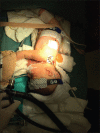Let us save the brain with cerebral oximeter: Two case reports
- PMID: 30688282
- PMCID: PMC6369595
- DOI: 10.4103/ajps.AJPS_117_16
Let us save the brain with cerebral oximeter: Two case reports
Abstract
In the neonates, tracheal atresia and tracheoesophageal fistula (TEF) surgery may result in hemodynamic instabilization, leading to cerebral perfusion insufficiency due to the retraction of the pulmonary vessels and truncus brachiocephalicus. We represented one male and one female neonates which were performed thoracoscopic primary repair of TEF through right thoracotomy at the 3th and 4th postpartum day. Anesthesia was induced using sodium thiopental (5 mg/kg), fentanyl 4 mcg, and rocuronium (0.5 mg/kg) given through intravenous route. Sevoflurane 2% and 50% O2in air were used for the maintenance therapy. During the right lung compression to expose posterior esophagus, no value was observed on the pulse oximeter (PO) probe placed on the right hand, and radial artery was not palpated. At the same time, oxygen saturation was observed as 96%-97% on the left foot probe. As the right cerebral oximeter values (rSO2) were rapidly decreased to 31%, the lung compression was ceased. Right pulse oximeter and right rSO2measurements return to the baseline levels. For the second case - different from the first case -both left and right rSO2was rapidly decreased to 40% levels and return to the baseline levels after was removed the retractors. Right PO and right and left cerebral rSO2values returned to baseline immediately when the retractor compression was ended During the operations involving the great vessels in neonates, cerebral perfusion could be preserved using cerebral oximeter. Cerebral oximeter is more efficient than pulse oximeter for detecting cerebral tissue oxygenation and could be helpful to minimize neuronal damage in the neonates.
Keywords: Anesthesia; esophageal atresia; near-infrared spectroscopy; neonatal surgery; tracheoesophageal fistula.
Conflict of interest statement
None
Figures



Similar articles
-
Cerebral oximetry monitoring with near infrared spectroscopy detects alterations in oxygenation before pulse oximetry.J Intensive Care Med. 2008 Nov-Dec;23(6):384-8. doi: 10.1177/0885066608324380. J Intensive Care Med. 2008. PMID: 18794168 Clinical Trial.
-
Infants with esophageal atresia and right aortic arch: Characteristics and outcomes from the Midwest Pediatric Surgery Consortium.J Pediatr Surg. 2019 Apr;54(4):688-692. doi: 10.1016/j.jpedsurg.2018.08.002. Epub 2018 Aug 21. J Pediatr Surg. 2019. PMID: 30224238
-
[Measurement of brain regional oxygen saturation in neonates in China: a multicenter randomized clinical trial].Zhonghua Er Ke Za Zhi. 2009 Jul;47(7):517-22. Zhonghua Er Ke Za Zhi. 2009. PMID: 19951514 Clinical Trial. Chinese.
-
Endoscopic esophageal and tracheal cauterization for closure of recurrent tracheoesophageal fistula: A case report and review of the literature.Int J Pediatr Otorhinolaryngol. 2017 Jul;98:158-161. doi: 10.1016/j.ijporl.2017.04.051. Epub 2017 May 2. Int J Pediatr Otorhinolaryngol. 2017. PMID: 28583493 Review.
-
Esophageal atresia associated with a rare vascular ring and esophageal duplication diverticulum: a case report and review of the literature.J Pediatr Surg. 2012 Oct;47(10):1926-9. doi: 10.1016/j.jpedsurg.2012.07.051. J Pediatr Surg. 2012. PMID: 23084209 Review.
References
-
- Clark DC. Esophageal atresia and tracheoesophageal fistula. Am Fam Physician. 1999;59:910. - PubMed
-
- Morgan GE, Mikhail MS, Murray MJ. 4th ed. United States: McGraw-Hill Companies; 2006. Paediatric Anesthesia: Clinical Anesthesiology; p. 941.
-
- Broemling N, Campbell F. Anesthetic management of congenital tracheoesophageal fistula. Paediatr Anaesth. 2011;21:1092–9. - PubMed
-
- Mahle WT. Neurologic and cognitive outcomes in children with congenital heart disease. Curr Opin Pediatr. 2001;13:482–6. - PubMed
-
- Wernovsky G, Shillingford AJ, Gaynor JW. Central nervous system outcomes in children with complex congenital heart disease. Curr Opin Cardiol. 2005;20:94–9. - PubMed
Publication types
MeSH terms
Substances
LinkOut - more resources
Full Text Sources
Research Materials
